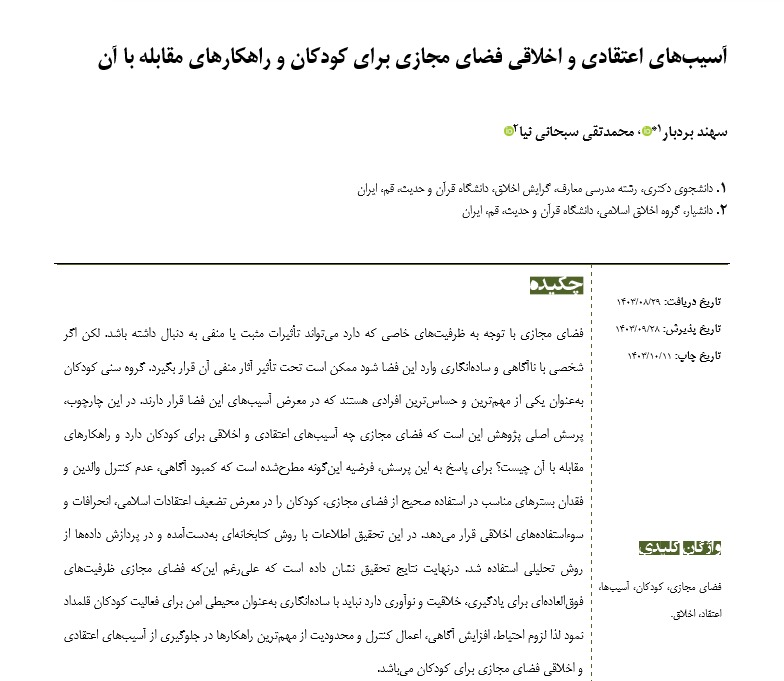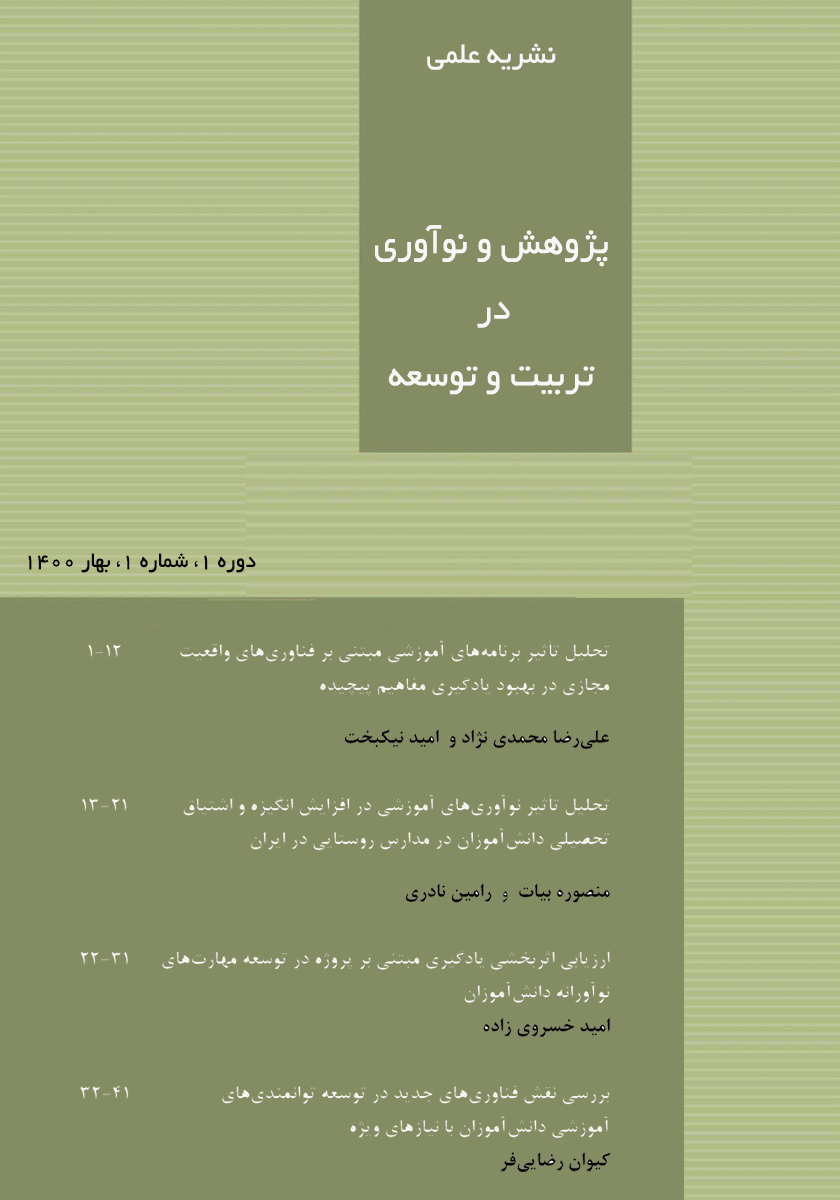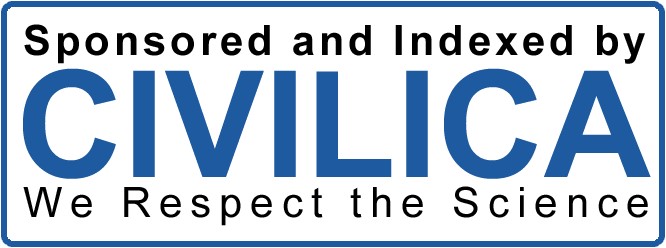The Religious and Ethical Risks of Cyberspace for Children and Strategies for Mitigation
Keywords:
Cyberspace, Children, Harms, Belief, EthicsAbstract
Cyberspace, given its unique capabilities, can have both positive and negative impacts. However, if individuals engage with this space naively and without adequate knowledge, they may become vulnerable to its negative effects. Children are among the most significant and sensitive groups exposed to the potential harms of cyberspace. Within this context, the central research question is: What are the religious and ethical risks of cyberspace for children, and what strategies can mitigate these risks? To address this question, the hypothesis posits that a lack of awareness, insufficient parental supervision, and the absence of appropriate frameworks for safe and effective use of cyberspace expose children to the weakening of Islamic beliefs, moral deviations, and ethical exploitation. This study employs a library-based method for data collection and an analytical approach for data processing. The findings indicate that while cyberspace holds immense potential for learning, creativity, and innovation, it should not be simplistically regarded as a safe environment for children's engagement. Thus, precaution, heightened awareness, supervision, and the enforcement of restrictions are critical strategies to prevent religious and ethical harms in cyberspace for children.
Downloads
References
Izadi-Fard AA, Hossein-Nejad SM. Electronic Jurisprudence in the Islamic-Iranian Model of Progress. Tehran:
Institute of Islamic-Iranian Model of Progress; 2016. 33 p.
Hasanbeigi E. Rights and Security in Cyberspace. Tehran: Institute of Contemporary Abrar Studies and Research;
Javidi E, Ahmadi H, Rajabi M. A Sociological Study of the Impact of Virtual Social Networks on the Generation Gap:
A Case Study of Shiraz University Students. Scientific-Research Quarterly of Social Development. 2021;16(2):1-32.
Dardashti AR. On the Reasons for the Spread of Mass Doubts in Cyberspace. 2016 2016-02.
Tomczyk Ł, Solecki R. Problematic Internet Use and Protective Factors Related to Family and Free Time Activities
among Young People. Educational Sciences: Theory and Practice. 2019;19:1-13. doi: 10.12738/estp.2019.3.001.
Barazandeh M. Addiction to Mobile Phones and Cyberspace: A Serious Threat to Families. 2022 2022-06-20.
Malek Shoar M, Tadayon A. The Impact of Cyberspace on Committing Immoral Acts. Tali'eh-e-Hoqoq Journal.
(6):150-88.
Smith PK, Madsen K, Moody J. What causes the age decline in reports of being bullied in school? Towards a
developmental analysis of risks of being bullied. Educational Research. 1999;41:267-85. doi: 10.1080/0013188990410303.
Zare'an A. What Do You Know About Virtual Violence? 2021.
Kharazani SH. The Relationship Between Cyber Usage and Students' Tendency Towards Violence. Information and
Criminal Research. 2016;11(1):161-84.
Malahi N. The Role of Islamic Religious Teachings in Preventing the Destructive Effects of Cyberspace on Families.
Rahnaward-e-Noor Quarterly. 2017(60):55.
Munro ER. The protection of children online: a brief scoping review to identify vulnerable groups. 2011.
Ghanizadeh Bafghi M, Hosseinzadeh Sarsheki A. An Inquiry into the Phenomenon of Cyber Pornography and Child
Cyber Seduction in Light of Iranian Jurisprudence and Law. Article 8. 2023;28(78):197-228.
Chandler D, Munday R. A Dictionary of Social Media. Oxford: Oxford University Press; 2016.
Patchin JW. Catfishing as a Form of Cyberbullying. Cyberbullying Research Center. 2013.
Barqi R, Mostaneh Y. The Impact of Cyberspace on the Islamic Education of Students: Challenges and Solutions.
Rahnaward-e-Noor Quarterly. 2018(63):35-45.
Montgomery C. Is YouTube Kids Safe? What Is YouTube Kids? 2023 [updated December 17, 2023]. Available from:
https://parentintel.com/is-youtube-kids-safe.
Ghasemzadeh Barki S, Manteghi M, Mohammadi M. Examining Mothers' Abuse of Children in Blogging and Its
Impact on Their Psychological Health. Research in Psychological Health. 2020;14(2):34-49.
Shahid Thani Za-DiA. Al-Rawdah al-Bahiyyah fi Sharh al-Lum'ah al-Dimashqiyyah: Section of Shia Jurisprudence
of the Eighth Century; 1967.
Qadiri Modarres MJ. Misleading Books from the Perspective of Imamiyya Jurisprudence and Iranian Law: Master's
thesis in Islamic Studies, Department of Jurisprudence and Fundamentals of Islamic Law; 2013.
Meshkini AAF. Istilahat al-Usul wa Mu'azam Abhathiha. Qom: Al-Hadi Publications; 1992.
Bojnourdi H, Mehrizi M, Derayati MH. Al-Qawa'id al-Fiqhiyya (Al-Bojnourdi). Qom, Iran: Al-Hadi Publications;
Tusi MiH. Al-Amali. Islamic Studies Section: Al-Ba'thah Institute; 1994.

Downloads
Published
Submitted
Revised
Accepted
Issue
Section
License
Copyright (c) 2024 Journal of Study and Innovation in Education and Development

This work is licensed under a Creative Commons Attribution-NonCommercial 4.0 International License.










